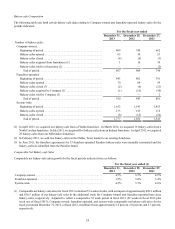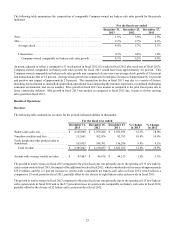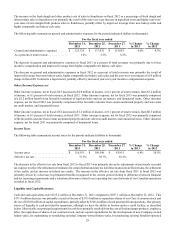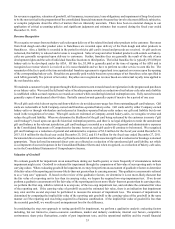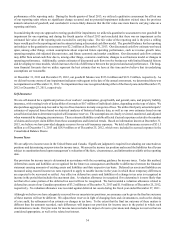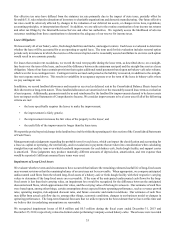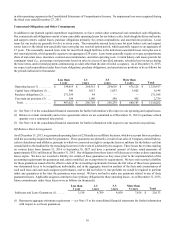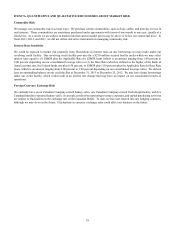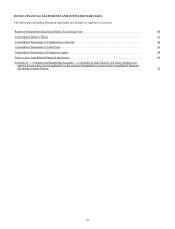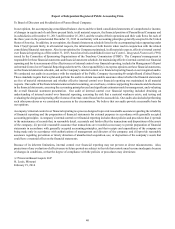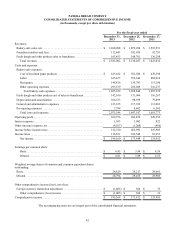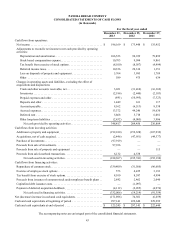Panera Bread 2013 Annual Report Download - page 42
Download and view the complete annual report
Please find page 42 of the 2013 Panera Bread annual report below. You can navigate through the pages in the report by either clicking on the pages listed below, or by using the keyword search tool below to find specific information within the annual report.34
performance of the reporting units. During the fourth quarter of fiscal 2013, we utilized a qualitative assessment for all but one
of our reporting units where no significant change occurred and no potential impairment indicators existed since the previous
annual evaluation of goodwill, and concluded it is more-likely-than-not that the fair value was more than its carrying value on a
reporting unit basis.
In considering the step one approach to testing goodwill for impairment, we utilized a quantitative assessment to test goodwill for
impairment for one reporting unit during the fourth quarter of fiscal 2013 and concluded that there was no impairment as the
estimated fair value of the reporting unit exceeded its carrying value. The fair value of the reporting unit is the price a willing
buyer would pay for the reporting unit and is estimated using a discounted cash flow model. The goodwill balance for the reporting
unit subject to the quantitative assessment was $2.2 million at December 31, 2013. Our discounted cash flow estimate was based
upon, among other things, certain assumptions about expected future operating performance, such as revenue growth rates,
operating margins, risk-adjusted discount rates, and future economic and market conditions. Our discounted cash flow estimate
may differ from actual cash flow due to, among other things, economic conditions, changes to our business model or changes in
operating performance. Additionally, certain estimates of discounted cash flow involve businesses with limited financial history
and developing revenue models, which increases the risk of differences between the projected and actual performance. The long-
term financial forecasts that we utilize represent the best estimate that we have at this time and we believe that its underlying
assumptions are reasonable.
At December 31, 2013 and December 25, 2012, our goodwill balance was $123.0 million and $121.9 million, respectively. As
we did not become aware of any impairment indicators subsequent to the date of the annual assessment, we determined there was
no impairment as of December 31, 2013. No impairment loss was recognized during either of the fiscal years ended December 25,
2012 or December 27, 2011, respectively.
Self-Insurance
We are self-insured for a significant portion of our workers’ compensation, group health, and general, auto, and property liability
insurance, with varying levels of deductibles of as much as $0.7 million of individual claims, depending on the type of claim. We
also purchase aggregate stop-loss and/or layers of loss insurance in many categories of loss. We utilize third party actuarial experts’
estimates of expected losses based on statistical analyses of historical industry data, as well as our own estimates based on our
actual historical data to determine required self-insurance reserves. The assumptions are closely reviewed, monitored, and adjusted
when warranted by changing circumstances. These estimated liabilities could be affected if actual experience related to the number
of claims and cost per claim differs from these assumptions and historical trends. Based on information known at December 31,
2013, we believe we have provided adequate reserves for our self-insurance exposure. We held self-insurance reserves of $31.5
million as of December 31, 2013 and $28.9 million as of December 25, 2012, which were included in accrued expenses in the
Consolidated Balance Sheets.
Income Taxes
We are subject to income taxes in the United States and Canada. Significant judgment is required in evaluating our uncertain tax
positions and determining our provision for income taxes. We assess the income tax position and record the liabilities for all years
subject to examination based upon management’s evaluation of the facts, circumstances, and information available at the reporting
date.
Our provision for income taxes is determined in accordance with the accounting guidance for income taxes. Under this method,
deferred tax assets and liabilities are recognized for the future tax consequences attributable to differences between the financial
statement carrying amounts of existing assets and liabilities and their respective tax basis. Deferred tax assets and liabilities are
measured using enacted income tax rates expected to apply to taxable income in the years in which those temporary differences
are expected to be recovered or settled. Any effect on deferred tax assets and liabilities of a change in tax rates is recognized in
income in the period that includes the enactment date. A valuation allowance is recognized if we determine it is more likely than
not that all or some portion of the deferred tax asset will not be recognized. We had recorded a valuation allowance related to
deferred tax assets of our Canadian operations of $3.2 million as of December 31, 2013 and $1.8 million as of December 25, 2012,
respectively. No valuation allowance was recorded against deferred tax assets during the fiscal year ended December 27, 2011.
Although we believe we have adequately reserved for our uncertain tax positions, no assurance can be given the final tax outcome
of these matters will not be different. We adjust these reserves in light of changing facts and circumstances, such as the closing
of a tax audit, the refinement of an estimate or changes in tax laws. To the extent that the final tax outcome of these matters is
different than the amounts recorded, such differences will impact our provision for income taxes in the period in which such
determination is made. Our provision for income taxes includes the impact of reserve provisions and changes to reserves that are
considered appropriate, as well as the related net interest.


